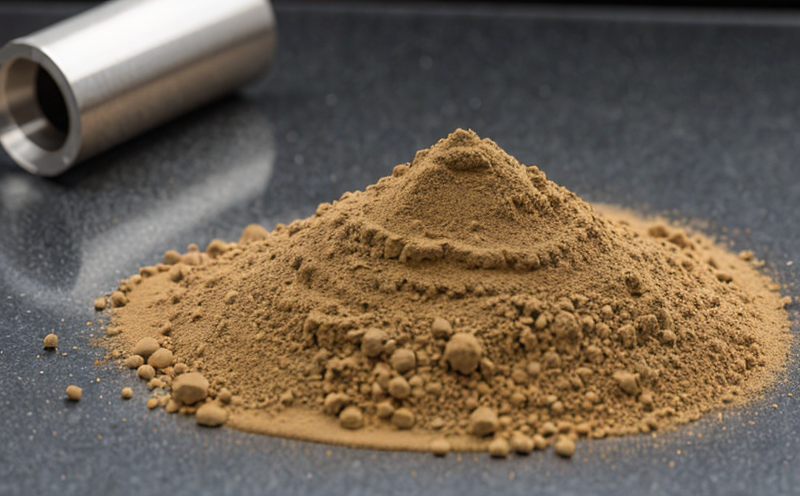ASTM D4404 Pore Volume and Surface Area Testing
The ASTM D4404 pore volume and surface area test is a critical analytical procedure used to characterize the porosity of various raw materials, particularly those utilized in additive manufacturing (AM) and 3D printing processes. This method provides essential insights into the microporous structure of powders that are integral for successful AM processes. Understanding these structural properties ensures optimal performance during additive manufacturing, where material quality directly influences part integrity, mechanical strength, and surface finish.
The test is conducted using a gas adsorption technique, often employing nitrogen or argon as the adsorbent at temperatures ranging from 77 to 250 Kelvin. This approach allows for the determination of both micropore (below 2 nm) and mesopore (between 2 and 50 nm) volume and surface area. The results are typically reported in terms of milliliters per gram (ml/g) for pore volume and square meters per gram (m2/g) for specific surface area.
The importance of this test cannot be overstated, especially in sectors where precision is paramount—such as aerospace, automotive, medical devices, and electronics. For instance, the pore structure affects the dispersion of functional additives within the powder matrix, influencing properties like electrical conductivity or thermal stability. Additionally, surface area plays a crucial role in determining the reactivity of materials during AM processes.
Specimen preparation for ASTM D4404 involves careful handling to avoid contamination and ensure accurate readings. This typically includes sieving the raw material to the desired particle size range (commonly 50-200 microns), degassing, and drying under controlled conditions. The prepared samples are then placed into the adsorption instrument for analysis.
The equipment used in this testing is sophisticated, including multi-purpose gas adsorption analyzers that can handle a wide range of sample types. These instruments are capable of producing detailed data on pore size distribution, which is essential for optimizing AM processes and ensuring compliance with industry standards. The data generated from these tests informs critical decisions regarding material selection and process optimization.
| Standard Name | Description |
|---|---|
| ASTM D4404-18 | American Society for Testing and Materials standard for the determination of total pore volume and surface area in microporous materials. |
| ISO 9276 | International Organization for Standardization method for the measurement of specific surface areas by gas adsorption. |
Applied Standards
The ASTM D4404 pore volume and surface area test is rigorously standardized by multiple international organizations, ensuring its reliability across different industries. The standard specifies the use of nitrogen or argon as adsorbents at specific temperatures to achieve accurate measurements of both micropore and mesopore volumes and surface areas.
The testing methodology outlined in ASTM D4404 is designed to be versatile enough for various raw materials, including those used in additive manufacturing. The standard emphasizes the importance of specimen preparation, which includes sieving the raw material into a specific particle size range (commonly 50-200 microns), degassing, and drying under controlled conditions.
The use of nitrogen or argon as adsorbents is critical for obtaining precise pore volume and surface area measurements. Nitrogen, being the most commonly used gas, provides data that closely reflects the true nature of the material's porosity. The standard also allows for the use of other gases under specific conditions, ensuring flexibility in testing different types of materials.
The ASTM D4404 method is complemented by other international standards such as ISO 9276, which provides additional guidelines on the measurement of specific surface areas by gas adsorption. These standards ensure that the results obtained from the test are consistent and comparable across different laboratories and industries.
| Standard Name | Description |
|---|---|
| ASTM D4404-18 | American Society for Testing and Materials standard for the determination of total pore volume and surface area in microporous materials. |
| ISO 9276 | International Organization for Standardization method for the measurement of specific surface areas by gas adsorption. |
Industry Applications
- Aerospace: Ensuring the integrity and performance of critical components through precise characterization of raw materials.
- Automotive: Optimizing parts for lightweighting and improving fuel efficiency by selecting materials with optimal porosity.
- Medical Devices: Guaranteeing that implants and other medical devices have consistent and reliable properties, ensuring patient safety.
- Electronics: Enhancing the performance of electronic components through optimized material selection and processing.
International Acceptance and Recognition
The ASTM D4404 pore volume and surface area test is widely recognized and accepted across various industries, including additive manufacturing and 3D printing. Its adoption by leading standards bodies ensures that the results are internationally comparable and reliable.
Many global organizations, such as the International Organization for Standardization (ISO) and the European Committee for Standardization (CEN), have endorsed ASTM D4404, further cementing its position as a preferred method for raw material characterization. This widespread acceptance underscores the importance of this testing in ensuring high-quality materials for AM processes.
Compliance with ASTM D4404 is not only beneficial for quality assurance but also essential for meeting regulatory requirements and achieving industry certifications. By adhering to this standard, manufacturers can demonstrate their commitment to producing reliable and consistent products, which is crucial in sectors where precision and repeatability are paramount.





